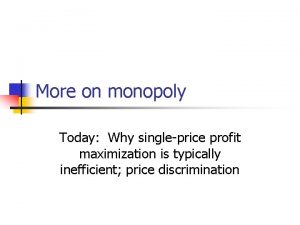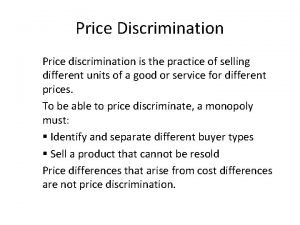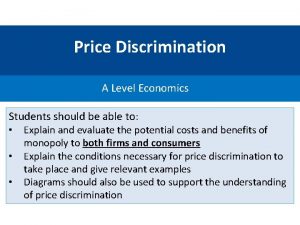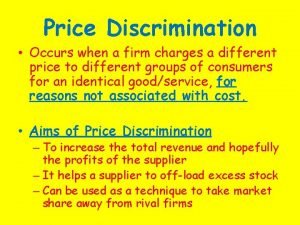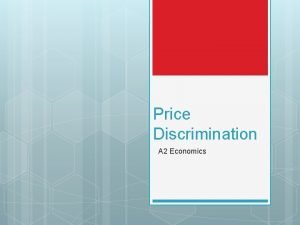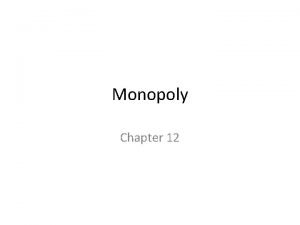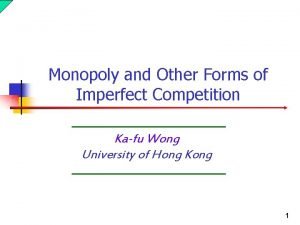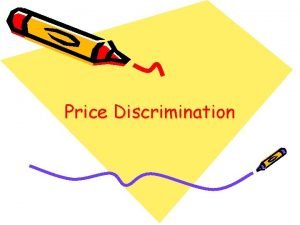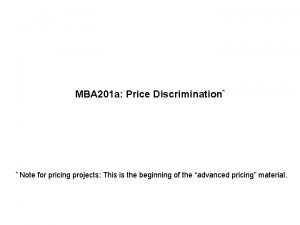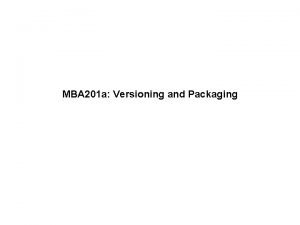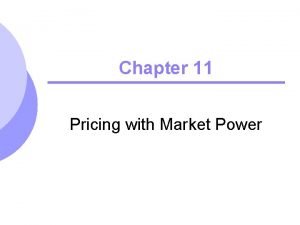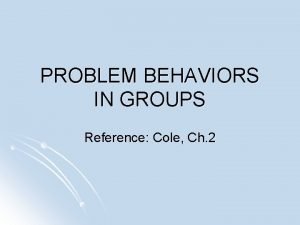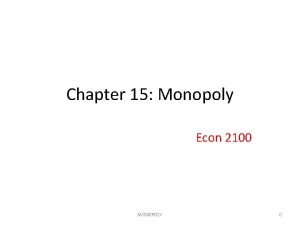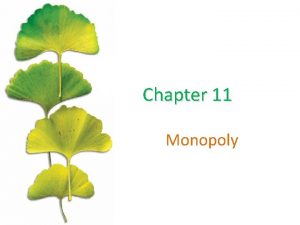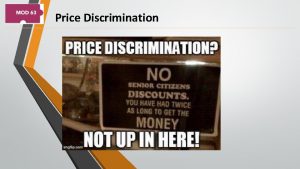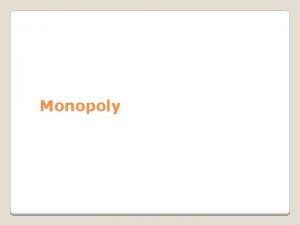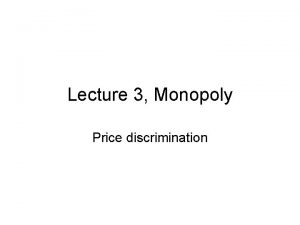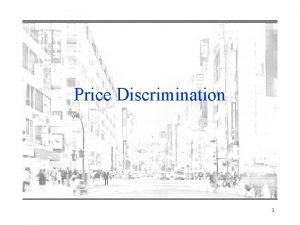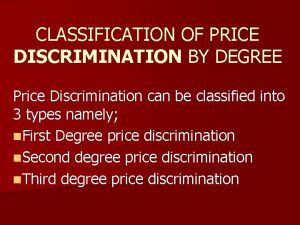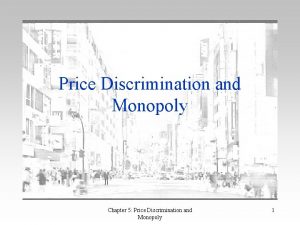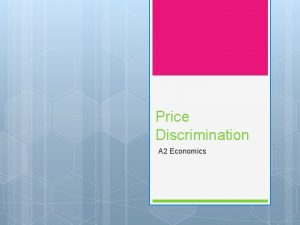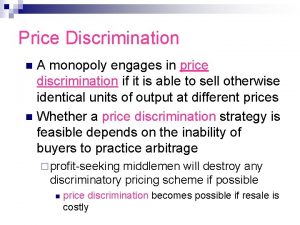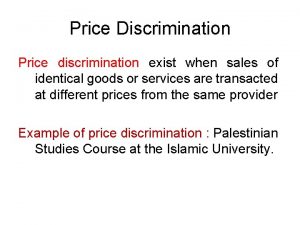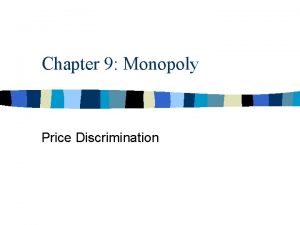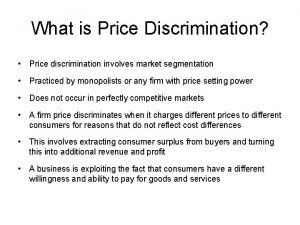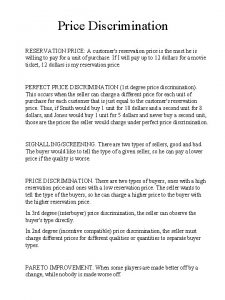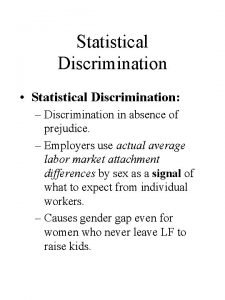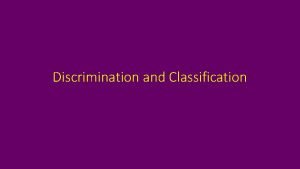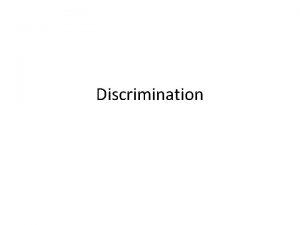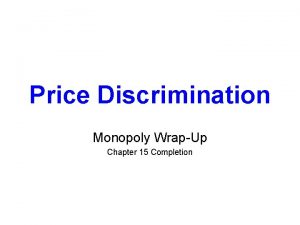Today Entry the monopolist Price discrimination the monopolist

























- Slides: 25

Today • Entry & the monopolist • Price discrimination & the monopolist

Entry and the Monopolist Why don’t others enter?

Barriers to Entry • Ordinarily, we expect that profits will attract entry to a market. • This might make it hard to remain a monopolist. • Expect to see a monopoly only when there are some kind of barriers to entry. • We will discuss four types of barriers to entry.

1. Economies of scale & natural monopoly P If another firm produced less than 10, 000 units, it would have higher AC and could be undercut in price. MC p* LRATC If it entered producing 10, 000 units, then price would be driven down below AC for both firms. D 20, 000 13, 000 10, 000 9, 000 Q

Natural Monopoly • Demand is low enough that there is only room for one firm producing at minimum average cost. • OR Economies of scale are so strong that LRAC are decreasing up to a very large quantity (relative to demand). • Public utilities are often natural monopolies.

Regulation of Natural Monopoly • Governments often create a legal monopoly to provide goods that are natural monopolies. • This makes it illegal to compete against the provider. • Governments then regulate the monopoly to force it to act more like a price taker. • Many public utilities are regulated.

2. Large Set-up Costs • Referring to large sunk costs of entry. • Includes developing product, advertising, setting up operations. • Potential entrants may be reluctant to bear these costs if they are not sure they will be able to break even. • Examples: • Virgin cola; wide-body airplane production

3. Patent Laws or Trade Secrets • It may be illegal or impossible to duplicate the product. • Secret formula for Coke • spiral ham-cutting machine • Polaroid cameras

Social Cost/Benefits of Patents • Costs: Creates a monopoly, which harms consumers. • Benefits: Provides an incentive to do R&D so as to earn monopoly profits for a while. Otherwise, maybe no innovation. • They are crudely balanced by giving patents for 17 years only.

4. Legal Barriers • Perhaps a legal monopoly (see regulation of natural monopolies, above). • Licensing requirements, such as in medicine or law.

Price Discrimination and the Monopolist

Type 2 Price Discrimination • When a seller approximates selling the units of a good for what they are worth to consumers. • The ice cream problem, when you set up quantity discounts.

Profit Maximization and Price Discrimination • The profit-maximizing rule (choose Q where MR = MC) applies only to “one price” situations. • If a monopolist is able to price discriminate, this will allow him to do better.

Price Discrimination on Graph P MC MR If the monopolist must charge only one price, what will he do? D Q

Price Discrimination on Graph P MC How much is his Producer’s Surplus? PM MR QM D Q

Price Discrimination on Graph P MC PM MR QM Can he increase it by offering different prices on different units? D Q

Price Discrimination on Graph P MC How are consumers affected by this? PM MR QM D Q

Type 3 Price Discrimination • When different types of consumers have different price elasticities of demand, a seller can try to charge different prices depending on who buys. • Must have a way of identifying the highvalue consumers from the others. • Must be able to prevent re-sale.

Example: Air Travel • Business v. leisure travelers • Who has more elastic demand? • How can the types be identified? • How is re-sale prevented?

Example: Movie ticket prices • Matinee v. evening viewers • Adult v. kid • Who has more elastic demand? • How can the types be identified? • How is re-sale prevented?

Type 1 Price Discrimination • When a seller sells each unit of a good for what it is worth to each consumers. • Called perfect price discrimination. • In this situation, the monopolist does provide the allocatively efficient level of output.

Perfect Price Discrimination P MC PM Each unit sells for a different price. The efficient quantity is provided. Sum of PS & CS is maximized (but CS = 0). No deadweight loss. MR QM QE D Q

Coming Up • Monopolistic competition & oligopoly • Group Work: Exercise related to monopolies

Instructions • For each product or market, identify a way that price discrimination is used. • Which type (I, II, or III) is it? • Are any devices needed to prevent re-sale or separate types of consumers?

Products or Markets • King’s Dominion (and other amusement • • parks). Think beyond adult v. child ticket prices. Hotel rooms in Florida Flea markets Legal and medical services Cheerios cereal
 How to calculate profit for monopoly
How to calculate profit for monopoly Perfectly price discriminating monopoly
Perfectly price discriminating monopoly Consumer surplus in a monopoly
Consumer surplus in a monopoly Kahulugan ng price support
Kahulugan ng price support Perfect price discrimination
Perfect price discrimination Perfect price discrimination คือ
Perfect price discrimination คือ Hurdle model of price discrimination
Hurdle model of price discrimination Price discrimination occurs when a firm
Price discrimination occurs when a firm Objectives of price discrimination
Objectives of price discrimination Monopoly perfect price discrimination
Monopoly perfect price discrimination Calculus vs algebra
Calculus vs algebra Student discount price discrimination
Student discount price discrimination Deadweight loss monopoly graph
Deadweight loss monopoly graph Double marginalization
Double marginalization Student discount price discrimination
Student discount price discrimination Types of price discrimination
Types of price discrimination Versioning price discrimination
Versioning price discrimination Second degree price discrimination graph
Second degree price discrimination graph Help rejecting complainer
Help rejecting complainer Perfectly discriminating monopolist
Perfectly discriminating monopolist Perfectly discriminating monopolist
Perfectly discriminating monopolist Unit4 competitors
Unit4 competitors Consumer surplus in a monopoly
Consumer surplus in a monopoly Today meeting or today's meeting
Today meeting or today's meeting Today's lesson or today lesson
Today's lesson or today lesson Are we having class today
Are we having class today
